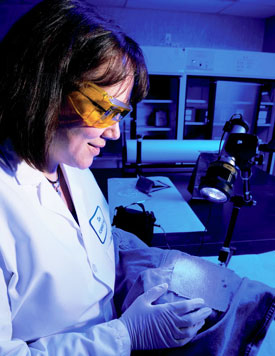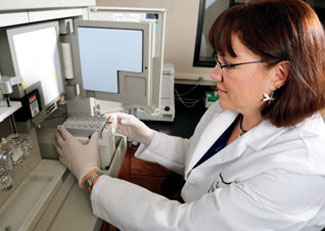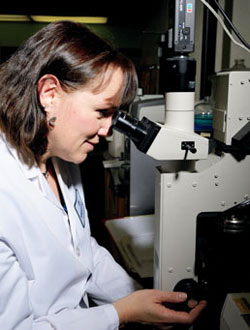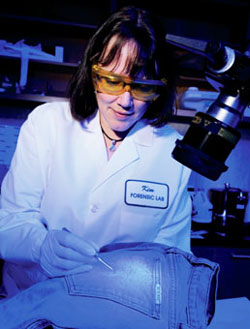
Kimberly Fish Rumrill '84 is smart, experienced and a master at figuring out crime scenes.
by David R. Morcom
Kimberly “Kim” Fish Rumrill '84 is a warm, highly intelligent woman with a calm demeanor and a ready smile. She's also a wife, mother of two teenagers, homemaker, and dogged puzzle solver for the New Hampshire State Police Forensic Science Laboratory in Concord, N.H. Her official title is Criminalist II, and her expertise is serology, the science that deals with serums, especially blood.
Kim's major at Colby-Sawyer was Medical Technology, and she says the hands-on skills she was taught gave her a strong foundation for all the science fields in which she's worked. She remembers with fondness professors such as Kathy Springsteen, Larry Dufault, Peter Mitchell and Helen Morrison. It was from them that she learned anatomy and physiology, microbiology, toxicology, child psychology, and the other sciences that started her on her career path.
“I remember they all seemed to have a good sense of humor,” Kim says, smiling at the recollection, “and the small class sizes made it easy to connect with them. It allowed them to know us as individuals and to specifically tailor the amount of help they offered each of us.
“I never got bored because a lot of the girls in my dorm were Med Tech students, so there was always a lot of camaraderie. I remember it used to get a little cold sometimes on the third floor of Burpee in the winter, so we'd study in the hall where we'd line up our hot air popcorn poppers down the hallway and get them going while we drank our two liter bottles of Tab.”
Kim's father was a detective, and law enforcement was in her blood, so to speak. After Colby- Sawyer, she found a job as a medical technologist in Keene, N.H., at the Keene Clinic. Meanwhile, she was developing an interest in forensic science from reading her father's professional detective magazines. She soon found herself going back to school at the University of New Haven (UNH) to study forensic science.

After graduation from UNH, Kim was told that you needed to wait for someone to die or retire in order to get a job in the N.H. State Police Forensic Science Laboratory. During a stint as a medical technologist at Dartmouth-Hitchcock Medical Center, Kim found that someone had, indeed, retired, and she was chosen to fill the position. That was 15 years ago.
When asked what type of evidence she receives and from whom, Kim says, “We receive our evidence from all police agencies in the State of New Hampshire, and some even comes from the FBI. We may receive evidence as diverse as swabs collected from crime scenes, sexual assault kits from hospitals, carpeting from a doctor's office or a car, weapons, all sorts of things, you name it.
“Because I'm a serologist, once evidence reaches our lab, I have the opportunity to participate in solving crimes having to do with blood or other bodily fluids, as well as DNA, which means I'm involved in helping to solve sexual assault and homicide cases. I take the evidence, which has either been bagged or placed in appropriate containers, to an examination room where it's spread out on clean, white paper on an exam table.”
Kim is a serologist, but a more colloquial term for her expertise is blood spatter expert. She explains that phrase as she seems to do everything, carefully and patiently. “A blood spatter expert is someone who studies the distribution, size of spatter, and patterns of blood at a crime scene, or on a person's clothing, or on a weapon, or wherever blood is found. What I'm actually doing in these situations is evaluating the blood stains and determining what I can say about them and what they may represent in terms of what took place to make those patterns.
“For example let's say I find a castoff pattern, which happens when somebody has used a blunt object like a bat. As they swing the bat it's going to cause a linear series of spatters that will travel along the wall or the ceiling. As the blood is being cast onto the wall, it forms droplets that are elliptical in shape and they'll have long tails that point in the direction of travel. That allows me to tell where in the room the crime took place.

“One pattern I remember in particular was a case where a knife was the murder weapon. As a knife is swinging perpendicular to a wall, the blood will come off both sides of the blade at the same time and create these tiny little twin spatters that are parallel to one another.”
As Kim explains it, there is a multi-step approach to looking at evidence. For example, when she's looking at a reddishbrown stain on clothing, she does a presumptive test for blood called the Kastle-Meyer test. The stain is swabbed and then a drop of the Kastle-Meyer solution, which is reduced phenolphthalein, is added to it. A second drop of three percent hydrogen peroxide is added. If the swab turns pink rapidly, then it's positive for blood. If you've ever watched any of the CSI shows on television, you've seen this test done numerous times.
There's another test that takes it one step further that can be used to determine anti-human hemoglobin, but, as Kim explains with a touch of humor, “We can only call our findings using this test as 'consistent with human blood' because it cross-reacts with ferrets, although we haven't had many problems with criminal ferrets in New Hampshire.”
When asked what gives her the most difficulty at a crime scene, Kim answers without hesitation. “When I arrive at a crime scene, the body is usually already gone. I can deal with almost anything, but sometimes the smell really bothers me. The way I deal with it is to wear a paper mask with strong perfume on it. There are times when I'll have flashbacks to the smell. If I'm at a scene and the smell is terrible, and then, weeks later back in the lab, the clothing comes in from that scene, I'll get a most unpleasant flashback to the smell.”
Kim feels that one of the things that makes her job rewarding is when she gets to think creatively and come up with an important piece of the puzzle that will help solve a case.
One case in particular involved a young girl and an older man who had assaulted her, but who had left no evidence on the girl. However, shortly after the assault, detectives were able to retrieve the suspect's underpants, and, as Kim explains, “I was examining them with an alternate light source we call a crime light. That's a light that shines at a blue-green wavelength of around 450 nanometers. We use it to look for the presence of body fluids on fabrics. As I studied the inner waistband area of the underpants, I saw a faint fluorescence. It struck me that it might be a transfer of the young girl's vaginal epithelial cells onto the suspect's waistband. So, I took a cutting of that and did a DNA analysis. What I had thought turned out to be correct. By finding this trace evidence on the criminal's underpants, I was able to show that the girl's DNA ended up where it shouldn't have been, which helped result in a conviction.”

Among the other tools of the trade Kim uses are yellow filter goggles that block UVA and UVB, the two spectrums of ultraviolet light, and allow her to more easily identify urine, semen, saliva, or sweat stains, and which stains may be from some other fluid. Once Kim determines what she believes the stain to be, she does a presumptive test using various chemicals to pin down the exact source of the stain. Finally, a cutting of the stain may be sent for DNA testing.
One of the common tools Kim uses is a biological microscope, but the new star of all the crime-solving tools, and the one that has changed the face of crime detection almost as much as fingerprints did, is the Capillary Electrophoresis Genetic Analyzer. This powerful tool is more simply called the DNA typing instrument, and it can deliver a DNA profile from a sample as small as 50 to 100 cells, which is about the size of the period at the end of this sentence.
While the tools for solving crimes have come a long way technologically, one tool has stayed the same, and Kim feels it may be the most important of all. “The crime scene investigator is close to the ultimate tool because the more you see, the more experienced you become, the more valuable you become. If you can get to the point where you can think outside the box, you've made a breakthrough. The instruments and tools we use can't think outside the box…yet, so the trained criminalist is currently the ultimate weapon in solving crimes.” With a CSI as dedicated as Kim, the bad guys better beware.
Kim is asked to testify in court about four or five times a year, and is more often asked to give depositions. While she does not particularly enjoy testifying in court, she says the upside is that you have a chance to interact with the jury. “With so many CSI shows on TV,” she explains, “juries seem to understand much more of what we explain in court. For example, if we use the terms Leuco Crystal Violet (LCV) or luminol, they know what those are.* In the old days we'd have to spend time explaining those chemicals and what they're used for. The downside of the CSI programs is that juries think you can get DNA off anything and everything, and that DNA can solve any crime. The CSI shows are accurate for the most part, but there are things they depict that sometimes make us laugh down at the lab.
“The worst pitfall in court,” Kim says with just a hint of agitation, “is when you get what I call 'a mean attorney' who may show you a book you've never seen before and ask if you've read it. When you say no, he jumps right on it and asks why you haven't read it and proposes that it's essentially the bible for your field of science. Then, even if you say, 'No, that's a pathology book,' he still may have discredited you a little bit with the jury.”

Kim has seen difficult sights, smelled terrible smells, and has, at the least, brushed shoulders with the worst in human behavior. You would think it might wear her down emotionally, but Kim rejects that thought. “When we go to a crime scene,” she says, “yes, we may be walking into something that's horribly gross, bloodstained and miserable, but I approach each crime scene now as if I'm looking at pieces of a puzzle. I just want to figure out how everything fits into place. I'll see different patterns in different rooms, and I'll picture in my mind the scenarios that might have taken place. What's rewarding is when you can piece together what happened at a particular scene from what you've observed. Maybe you can tell that a suspect is lying about committing a crime in self defense because of the way the bloodshed event is evidenced on the walls or floor. Or maybe you discover a piece of hardto- spot evidence that will help nail the lid shut on a criminal.”
Kim finds it most satisfying that she can work on crime by solving puzzles from start to finish. Unlike many in her field who are more specialized, Kim can go from the crime scene to doing the serology work and then take it to DNA. “I like having the ability to put all of the pieces together and then, hopefully, seeing a completed picture. You have to have a passion for your job. In every unit in the lab, whether it's fingerprinting, firearms, computers or the drug section, the thing that gives people the strength they need is their passion for the job, wanting to solve their part of the puzzle. It's simply a love for what you do. It's also the challenge because just as technology advances to help us in the lab, the bad guys are using it to help themselves as well.”
For now, Kim is perfectly happy as a puzzle-solver, but she has other interests that she may pursue in the future. She teaches about blood spatter, serology and DNA at local high schools, and she feels when she's ready to retire she may do more of this, as well as consult on forensic science. And then, of course, there's always that book that needs to be written, which might start something like this:
It's a pitch black night and I'm standing in the bathroom of an isolated farm at the end of a long dirt road. The farm belongs to Sheila LaBarre, a suspected serial killer. The window is open to let in fresh air, and I can hear the crickets chirping. Other than that hypnotic sound, the night is still, and the inky blackness presses heavily through the window. I'm accompanied by a photographer and a police officer, but we don't speak. I begin to spray the shower stall with luminol. As I spray, eerily glowing areas of blue phosphorescence emerge from the darkness. This is where blood has run, where a bloody handprint has been left, where a blood spatter pattern shows itself. Each of us feels the hair rising on our arms and the back of our necks. Each of us sucks in our breath with a low whoosh as these creepy vestiges of crime begin to appear. The blue glow brings forth answers no longer in hiding, as well as a haunting, chilling echo of past violence.


